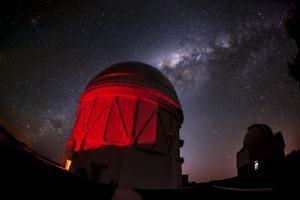Centro de Excelencia Severo Ochoa
Menu
Search

The Dark Energy Survey (DES) collaboration, to which the Institute for Theoretical Physics (UAM-CSIC) belongs, and the South Pole Telescope (SPT) collaboration have published updated data on key cosmological parameters such as matter content and the rate of expansion of the universe, using a combination of DES, SPT and Planck satellite data.
The so-called cosmological parameters describe the evolution of matter within the universe, and scientists use them to describe the properties of the universe, such as its expansion rate and curvature.
Thus, they have enabled us to cross-check previous DES results in a robust and consistent manner.
An updated map of gravitational lensing effects on cosmic microwave background photons by massive cosmic structures, such as galaxies and galaxy clusters, was constructed by the SPT Collaboration using data from Planck and SPT. DES measurements of the galaxies' positions and shapes, along with the distibution of matter around them, were correlated with the map data.

Compared with previously obtained values, the analysis provided cosmological parameters with lower uncertainty.There may, however, be uncertainty in the data resulting from noise in the measurements used to determine these parameters, causing inaccurate inferences from their values.
According to Yuuki Omori, a member of the University of Chicago DES and SPT collaborations and a researcher at the University of Chicago, measurements taken with a single telescope may be subject to systematic errors. The data can be made more robust when two telescopes are used".
DES: Three statistical measurements that are unprecedented
It is possible to measure the content and evolution of the universe in more than one way.Specifically, the Dark Energy Survey (DES) Collaboration uses three measurements.Statistical measurements of galaxies are helpful in determining cosmological parameters such as the density of dark matter and the rate of cosmic expansion, among others.
Early in 2023, the DES collaboration published data from three years of observations, covering a three-fold larger area of the sky than their previous publication.Despite the fact that the new analysis supports the standard cosmological model, the measurements are of unprecedented precision. In collaboration with Planck and SPT data, these are the data used for the development of updated cosmological parameters.
The main DES observations cover three aspects: galaxy clustering (the tendency for galaxies to appear together in the sky), cosmic shear (the distortions in the shape of galaxies caused by gravitational lensing), and a combination of both.DES conducts all of its observations using a telescope in Chile, unlike other collaborations.Combining measurements taken by different instruments or using different methods can lead to potential pitfalls.
About one-eighth of the entire sky is covered by the new observations, which cover nearly 5,000 square degrees. Several of the estimated parameters of cosmology, including the amplitude of the clump of matter and the equation of state of dark energy, are consistent with those predicted by the standard model of cosmology, in which a cosmological constant is used to describe dark energy.
In the near future, the uncertainty in the key parameters will be less than 3%, which will allow alternative theories to be ruled out.The main objective of the project is to collect the positions of millions of galaxies across more than a third of the sky.
Physicists can map clusters and superclusters of galaxies by using a three-dimensional map of the cosmos.Structures such as these carry echoes of their original formation, when they were simply ripples in the primordial cosmos.Physicists can use the DES data to determine the universe's full expansion history by detecting these echoes.
The evolution of Observational Cosmology over the past two decades is fascinating, especially since the discovery of the accelerating expansion of the universe. We now know much more about our cosmological environment, and we can distinguish an expansion resulting from a cosmological constant from alternative explanations of this expansion", commented Juan García-Bellido, IFT researcher and active member of DES since 2005.
About Dark Energy Survey
DES is funded by the following institutions: the U.S.The Department of Energy's Office of Science, the National Science Foundation, the Division of Astronomical Sciences of the National Optical Astronomy Observatory at Cerro Tololo, Chile; the Science and Technology Facilities Council of the United Kingdom; the Ministry of Science, Innovation and Universities of Spain; the National Institute of Science and Technology of Brazil; and the members of DES.
A number of Spanish institutions participate in DES-Spain, including the Center for Energy, Environmental and Technological Research (CIEMAT), the Institute of Space Sciences (ICE-CSIC), the Institute of High Energy Physics (IFAE) and the Institute for Theoretical Physics (IFT). The Autonomous University of Madrid (UAM) and CSIC are participating institutions.
A complete list of participating institutions and more information about DES can be found at: https://www.darkenergysurvey.org.
Source: IFT & Physics Magazine
Social media